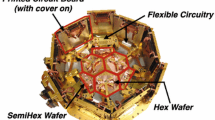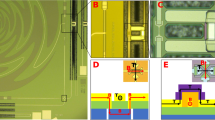Abstract
We report on the development of a polarization-sensitive dichroic (150/220 GHz) detector array for the Cosmology Large Angular Scale Surveyor (CLASS) delivered to the telescope site in June 2019. In concert with existing 40 and 90 GHz telescopes, the 150/220 GHz telescope will make observations of the cosmic microwave background over large angular scales aimed at measuring the primordial B-mode signal, the optical depth to reionization, and other fundamental physics and cosmology. The 150/220 GHz focal plane array consists of three detector modules with 1020 transition edge sensor bolometers in total. Each dual-polarization pixel on the focal plane contains four bolometers to measure the two linear polarization states at 150 and 220 GHz. Light is coupled through a planar orthomode transducer fed by a smooth-walled feedhorn array made from an aluminum–silicon alloy (CE7). In this work, we discuss the design, assembly, and in-laboratory characterization of the 150/220 GHz detector array. The detectors are photon-noise limited, and we estimate the total array noise-equivalent power to be 2.5 and 4 \({\text {aW}}\,\sqrt{{\text {s}}}\) for 150 and 220 GHz arrays, respectively.





Similar content being viewed by others
Notes
BlueFors Cryogenics, www.bluefors.com.
References
J.W. Appel et al., ApJ 876, 126 (2019). https://doi.org/10.3847/1538-4357/ab1652
S. Dahal et al., Proc. SPIE 10708, 107081Y (2018). https://doi.org/10.1117/12.2311812
K.L. Denis et al., AIP Conf. Proc. 1185, 371 (2009). https://doi.org/10.1063/1.3292355
K. Rostem et al., Proc. SPIE 9914, 99140D (2016). https://doi.org/10.1117/12.2234308
K. U-Yen et al., IEEE Trans. Microw. Theory Tech. 56, 172–177 (2008). https://doi.org/10.1109/TMTT.2007.912213
K. Rostem et al., J. Appl. Phys. 115, 124508 (2014). https://doi.org/10.1063/1.4869737
E.J. Wollack et al., in IEEE MTT-S International Microwave Symposium vol. 1 (2010), pp. 177–180. https://doi.org/10.1109/MWSYM.2010.5517063
E.J. Crowe et al., IEEE Trans. Appl. Supercond. 23, 2500505 (2013). https://doi.org/10.1109/TASC.2012.2237211
A.M. Ali et al., Proc. SPIE 10708, 107082P (2018). https://doi.org/10.1117/12.2312817
K. Irwin et al., J. Low Temp. Phys. 167, 588–594 (2012). https://doi.org/10.1007/s10909-012-0586-7
E.S. Battistelli et al., J. Low Temp. Phys. 151, 908–914 (2008). https://doi.org/10.1007/s10909-008-9772-z
J. Pardo et al., IEEE Trans. Antennas Propag. 49, 12 (2001). https://doi.org/10.1109/8.982447
Z. Pan et al., arXiv:1905.07399 (2019)
K. Harrington et al., Proc. SPIE 10708, 107082M (2018). https://doi.org/10.1117/12.2313614
T. Essinger-Hileman et al., Proc. SPIE 9153, 91531I (2014). https://doi.org/10.1117/12.2056701
Acknowledgements
We acknowledge the National Science Foundation Division of Astronomical Sciences for their support of CLASS under Grant Nos. 0959349, 1429236, 1636634, and 1654494. CLASS uses detector technology developed under several previous and ongoing NASA grants. Detector development work at JHU was funded by NASA Grant No. NNX14AB76A. We further acknowledge the very generous support of Jim and Heather Murren (JHU A&S ’88), Matthew Polk (JHU A&S Physics BS ’71), David Nicholson, and Michael Bloomberg (JHU Engineering ’64). CLASS is located in the Parque Astronómico de Atacama in northern Chile under the auspices of the Comisión Nacional de Investigación Científica y Tecnológica de Chile (CONICYT).
Author information
Authors and Affiliations
Corresponding author
Additional information
Publisher's Note
Springer Nature remains neutral with regard to jurisdictional claims in published maps and institutional affiliations.
Rights and permissions
About this article
Cite this article
Dahal, S., Amiri, M., Appel, J.W. et al. The CLASS 150/220 GHz Polarimeter Array: Design, Assembly, and Characterization. J Low Temp Phys 199, 289–297 (2020). https://doi.org/10.1007/s10909-019-02317-0
Received:
Accepted:
Published:
Issue Date:
DOI: https://doi.org/10.1007/s10909-019-02317-0




